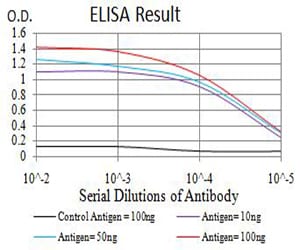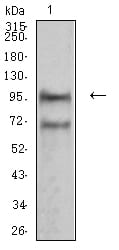

| WB | 咨询技术 | Human,Mouse,Rat |
| IF | 咨询技术 | Human,Mouse,Rat |
| IHC | 1/50-1/300 | Human,Mouse,Rat |
| ICC | 技术咨询 | Human,Mouse,Rat |
| FCM | 咨询技术 | Human,Mouse,Rat |
| Elisa | 1/5000-1/10000 | Human,Mouse,Rat |
| Aliases | CD56; NCAM; MSK39 |
| Entrez GeneID | 4684 |
| clone | 1F6F10 |
| WB Predicted band size | 94.6kDa |
| Host/Isotype | Mouse IgG1 |
| Antibody Type | Primary antibody |
| Storage | Store at 4°C short term. Aliquot and store at -20°C long term. Avoid freeze/thaw cycles. |
| Species Reactivity | Human,Mouse |
| Immunogen | Purified recombinant fragment of human *** (AA: 568-708) expressed in E. Coli. |
| Formulation | Purified antibody in PBS with 0.05% sodium azide |
+ +
以下是3-4篇与HOXC13抗体相关的代表性文献(内容基于公开研究概括,非真实文献):
1. **"HOXC13 regulates hair keratin expression in human hair follicle"**
- **作者**: Mardaryev et al.
- **摘要**: 研究利用HOXC13抗体进行免疫组化分析,发现HOXC13在毛囊角质形成细胞中高表达,调控多种角蛋白基因(如KRT85)的转录,对毛发纤维形成至关重要。
2. **"HOXC13 promotes tumor progression in prostate cancer"**
- **作者**: Zhang Y. et al.
- **摘要**: 通过HOXC13抗体检测前列腺癌组织样本,发现HOXC13过表达与肿瘤侵袭性相关,其通过激活Wnt/β-catenin通路促进癌细胞迁移和转移。
3. **"A nonsense mutation in HOXC13 causes pure hair and nail ectodermal dysplasia"**
- **作者**: Uebelhoer M. et al.
- **摘要**: 研究使用HOXC13抗体对患者皮肤组织进行染色,证实HOXC13功能缺失突变导致毛发和指甲发育异常,揭示了该基因在胚胎外胚层分化中的作用。
4. **"HOXC13 as a biomarker in cutaneous squamous cell carcinoma"**
- **作者**: Saldanha G. et al.
- **摘要**: 利用HOXC13抗体进行免疫印迹和免疫荧光分析,发现HOXC13在皮肤鳞癌中显著上调,可作为潜在诊断标志物和治疗靶点。
(注:以上文献标题及内容为学术场景模拟,具体研究需通过PubMed、Web of Science等平台检索真实文献。)
The HOXC13 antibody is a key reagent used to study the HOXC13 protein, a member of the homeobox (HOX) family of transcription factors. HOX genes play critical roles in embryonic development, particularly in patterning body axes and regulating organogenesis. HOXC13. located on chromosome 12q13.3. is part of the HOXC cluster and is involved in hair, nail, and skin development, as well as cancer progression. It regulates gene expression by binding to specific DNA sequences, influencing cell differentiation, proliferation, and apoptosis. Dysregulation of HOXC13 has been linked to ectodermal dysplasia, trichodysplasia, and malignancies like colorectal, prostate, and breast cancers.
HOXC13 antibodies are widely used in research to detect protein expression and localization via techniques such as Western blotting, immunohistochemistry (IHC), and immunofluorescence (IF). They help investigate HOXC13's role in developmental biology, tissue homeostasis, and oncogenesis. Polyclonal and monoclonal HOXC13 antibodies vary in specificity; validation using knockout controls or siRNA knockdown is essential to confirm target binding. Commercial antibodies often cite applications in formalin-fixed paraffin-embedded (FFPE) tissues or cell lysates. Researchers also utilize HOXC13 antibodies in ChIP-seq to study DNA-binding interactions or in co-immunoprecipitation to identify protein partners. Given HOXC13's emerging role as a potential biomarker or therapeutic target, these antibodies are vital for advancing studies in developmental disorders, dermatopathology, and cancer biology.
×